National Cadet Corps (India)
The National Cadet Corps is the youth wing of Armed Forces with its Headquarters at New Delhi, Delhi, India. It is open to school and college students on voluntary basis. National Cadet Corps is a Tri-Services Organisation, comprising the Army, Navy and Air Wing, engaged in grooming the youth of the country into disciplined and patriotic citizens. The National Cadet Corps in India is a voluntary organisation which recruits cadets from high schools, higher secondary, colleges and universities all over India. The Cadets are given basic military training in small arms and parades. The officers and cadets have no liability for active military service once they complete their course.
| National Cadet Corps | |
|---|---|
| Active | July 16, 1948 – present |
| Country | |
| Allegiance | |
| Role | Student Uniformed Group |
| Size | 13,00,000–15,00,000[1] |
| Headquarters | New Delhi |
| Motto(s) | एकता और अनुशासन Unity and discipline |
| Website | https://indiancc.nic.in |
| Commanders | |
| Director General | Lt Gen Rajeev Chopra, AVSM |
In state level trekking, Chella Shankara Narayanan of Tamil Nadu climbed kolli hills in less than 2 hours which still stands as a record even after 2 decades. Chella Shankara Narayanan is also trained shooter and won silver medal in NCC Nations meet.
History
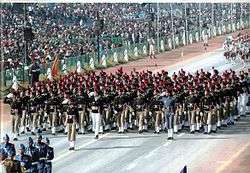
.jpg)
The NCC is the largest uniformed youth organization. Its motto is 'Unity and Discipline'.
The NCC in India was formed the National Cadet Corps Act of 1948. It can be traced back to the ‘University Corps’, which was created under the Indian Defence Act 1917, with the objective to make up for the shortage in the Army. In 1920, when the Indian Territorial Act was passed, the ‘University Corps’ was replaced by the University Training Corps (UTC). The aim was to raise the status of the UTC and make it more attractive to the youth. The UTC Officers and cadets dressed like the army. It was a significant step towards the Indianisation of armed forces. It was rechristened as UOTC so the National Cadet Corps can be considered as a successor of the University Officers Training Corps (UOTC) which was established by British Government in 1942. During World War II, the UOTC never came up to the expectations set by the British. This led to the idea that some better schemes should be formed, which could train more young men in a better way, even during peace. A committee headed by H N Kunzru recommended a cadet organisation to be established in schools and colleges at a national level. The National Cadet Corps Act was accepted by the Governor General and on 15 July 1948 the National Cadet Corps came into existence.
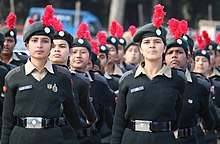
In 1948, the Girls Division was raised in order to give equal opportunities to school and college going girls. The NCC was given an inter-service image in 1950 when the Air Wing was added, followed by the Naval Wing in 1952. In the same year, the NCC curriculum was extended to include community development/social service activities as a part of the NCC syllabus at the behest of Late Pandit Jawaharlal Nehru who took keen interest in the growth of the NCC. Following the 1962 Sino-Indian War, to meet the requirement of the Nation, the NCC training was made compulsory in 1963. In 1968, the Corps was again made voluntary.[2]
During Indo-Pakistani war of 1965 & Bangladesh-Pakistani war of 1971, NCC cadets were the second line of defence. They organised camps to assist ordnance factories, supplying arms and ammunition to the front and also were used as patrol parties to capture enemy paratroopers. The NCC cadets also worked hand in hand with the Civil defence authorities and actively took part in rescue works and traffic control.[3]
After the 1965 and 1971 wars, the NCC syllabus was revised. Rather than just being a second line of defence, the revised NCC syllabus laid greater stress on developing qualities of leadership and officer like qualities. The military training which the NCC cadets received was reduced and greater importance was given to social service and youth management.
NCC Motto and Aim
The discussion for motto of NCC was started in 21th central advisory meeting(CAD) held on 11 August 1978. At that time there were many mottos in mind like "Duty and Discipline"; "Duty, Unity and Discipline"; "Duty and Unity"; "Unity and Discipline". later, at the 12th CAD meeting on 12 Oct 1980 they selected and declared "Unity and Discipline" as motto for the NCC.[4] In living up to its motto, the NCC strives to be and is one of the greatest cohesive forces of the nation, bringing together the youth hailing from different parts of the country and moulding them into united, secular and disciplined citizens of the nation.
Organisation
The NCC is headed by a Director General with the rank of Lieutenant General.
He is assisted by two Additional Director Generals (A and B) of two-star rank (major-general, rear-admiral or air vice-marshal). Five Brigadier level officers and other civil officials also assist him.
The Headquarters is located in Delhi. The organisational structure continues as follows:
- Directorate – There are 17 Directorates[5] located in the state capitals headed by an officer of the rank of a Maj Gen from the three Services.
- Division/ Regimental Corps – There are 3 such Specialised Corps located in Mumbai, Delhi and Bangalore respectively. They are independent of the state directorate and report to the HQ. These divisions form the support function of the regular NCC. Each is headed by a Senior Under Officer- an equivalent rank of (Lt.) General. Internal Affairs, Administration, Development and Research: Lt. Gen. [SUO] Arvind Shekhar (New Delhi). Recruitment, Training, Media and HR: Lt. Gen. [SUO] Prithvi Pant Negi (Mumbai). Special Forces, Infantry, Gallantry Committee & Commendations: Lt. Gen. [SUO] Bhav Salimath (Bangalore).
- Group – Depending upon the size of the state and growth of NCC in the states, Directorates have up to 14 Group Headquarters under them through which they exercise their command and control of the organisation in the state. Each group is headed by an officer of the rank of Brigadier or equivalent known as Group Commander.
- Battalion- Each NCC Group Headquarters control 5–7 units(Bns) commanded by Colonel/Lt.Col or equivalent.
- Company – Each Battalion consists of companies which are commanded by the Associate NCC Officer(ANO) of the rank of lieutenant to major.
In all there are 96 Group Headquarters in the country who exercise control over a network of 684 Army wing units (including technical and girls unit), 69 Naval wing units and 61 Air Squadrons. There are two training establishments namely Officers Training School, Kamptee (Nagpur, Maharashtra) and Women Officers Training School, Gwalior. Besides this Vice Chancellor's of various universities across India are conferred with honorary rank of commandant in NCC, to promote and support NCC in their respective University.
| Directorates |
|---|
| Andhra Pradesh & Telangana |
| Bihar & Jharkhand |
| Delhi |
| Gujarat Dadra & Nagar Haveli |
| Jammu & Kashmir and Ladakh |
| Karnataka & Goa |
| Kerala & Lakshdweep |
| Madhya Pradesh & Chhattisgarh |
| Maharashtra |
| North East Region (Arunachal Pradesh, Assam, Manipur, Meghalaya, Mizoram, Nagaland & Tripura) |
| Odisha |
| Punjab, Haryana, Himachal Pradesh and Chandigarh |
| Rajasthan |
| Tamil Nadu, Puducherry, Andaman & Nicobar |
| Uttarakhand |
| Uttar Pradesh |
| West Bengal & Sikkim |
Units
These 17 directorates are divided in total of 814 units divided in three service groups Army, Naval and Air. Out of those 684 are Army, 69 Naval and 61 Air units.[6]
Types of Army NCC units and their numbers are given below:
| Type of Unit | Number |
|---|---|
| ARMD SQN | 11 |
| ARTY REGT | 03 |
| ARTY BTY | 20 |
| ENGR REGT | 02 |
| ENGR COY | 11 |
| SIG REGT | 01 |
| SIG COY | 13 |
| MED BN | 02 |
| MED COY | 11 |
| R&V REGT | 03 |
| R&V COY | 15 |
| EME BN | 02 |
| EME COY | 06 |
| CTR | 11 |
| CTC | 12 |
| INF BN | 369 |
| INF INDEP COY | 46 |
| GIRLS BN | 97 |
| GIRLS INDEP COY | 12 |
Arms
Strength
- Army: Each battalion or unit of NCC consists of a number of platoons or coy. For senior division boys each platoon consists of 52 cadets and each coy consists 160 cadets. Each BN has 4 to 7 coys so each BN carries around 640 to 1120 cadets. A senior wing girls BN consists of 2 to 7 coy means a total of 320 to 1120 cadets. For junior division boys and junior wing girls each troop has 100 cadets and each BN has at least one troop.
- Navy: For senior division boys each BN or unit consists of 4 to 8 divisions and each division consists of 50 cadets. For senior wing girls similar arrangement exists as of senior division boys. For junior division boys and junior wing girls each BN has a troop of 100 cadets.
- Air: For senior division boys and senior wing girls each unit consists of at least 2 fleets each consists of 100 cadets. So each unit known as Squadron carries around 200 cadets. For junior wing girls and junior division boys each squadron has a troop consisted of 100 cadets.
However, each unit can have up to 24 troops of senior division boys expanding their strength to 2400 cadets but this is maximum limit.
Personnel
Cadet Ranks
| Under Officer ranks | SNCO ranks | JNCO ranks | Junior Cadets | |||||
|---|---|---|---|---|---|---|---|---|
| Army Wing Badges |  |
 |
 |
 |
 |
 |
No insignia | |
| Army Wing Ranks | Senior Under Officer (S.U/O) |
Junior Under Officer (J.U/O) |
Company Sergeant Major (CSM) |
Company Quartermaster Sergeant (CQMS) |
Sergeant (SGT) |
Corporal (CPL) |
Lance Corporal (L/CPL) |
Cadet (CDT) |
| Navy Wing Badges |  |
 |
No Equivalent |  |
 |
No insignia | No insignia | |
| Navy Wing Ranks | Senior Cadet Captain (SCC) |
Cadet Captain (CC) |
Petty Officer Cadet (PO CDT) |
Leading Cadet (LC) |
Naval Cadet I (NC I) |
Naval Cadet II (NC II) | ||
| Air Force Wing Badges |  |
 |
 |
 |
 |
 |
No insignia | |
| Air Force Wing Ranks | Cadet Senior Under Officer (C.S.U/O) |
Cadet Under Officer (C.U/O) |
Cadet Warrant Officer (CWO) |
Sergeant (SGT) |
Corporal (CPL) |
Leading Flight Cadet (LFC) |
Flight Cadet (FC) | |
JD boys and JW girls are given ranks up to Company Sergeant Major (CSM) in the Army Wing. Only SD boys and SW girls are given ranks above CSM in the Army Wing. In the Air Force and Navy Wings JD boys and JW girls are given ranks up to Cadet Warrant Officer/Petty Officer Cadet only and SD boys and SW girls are given ranks above Cadet Warrant Officer/Petty Officer Cadet.
Regular officers
The NCC directorates are headed by service officers of the rank of major general and equivalent; group headquarters are headed by service officers of the rank of brigadiers and equivalent, and units are headed by service officers of the rank of colonel(TS)/lieutenant colonel/major or equivalent. They are responsible for proper training, planning and execution of NCC activities.
Whole time lady officers
A cadre of whole time lady officers (WTLO) with cadre strength 110 officers has been sanctioned in 1995. They are to be commissioned partly through departmental channel and partly through UPSC in a phased manner.
Associate NCC officer
ANO is an important link in the NCC organization between the BN and the cadets. As a matter of fact, ANO is the feeder node of NCC since he / she is the one who is in direct contact with the cadets all throughout the year. There are two training establishments namely Officers Training Academy, Kamptee and Officers Training Academy, Gwalior. These two institutions trains the school and college teachers selected to head the company/troop. Courses in these institutions range from 21 days to 90 days in duration.
Associate NCC officers are given following ranks according to their seniority and their training.
ANOs are commissioned in NCC and not in regular Armed forces.
- For colleges(in charge of SD & SW): (NCC Army Wing)
- Major
- Captain
- Lieutenant
- For schools(in charge of JD & JW (equivalent commissioned Officer)):
- Chief Officer
- 1st Officer
- 2nd Officer
- 3rd Officer
Uniform
Army cadets wear khaki uniform. Naval cadets wear white uniform of Navy. Air Force cadets wear light blue grey (LBG) uniform. The uniform is compulsory on all the occasions.
Cadets from SD boys Army wing wear khaki full sleeve shirt and trousers & cadets from JD wear khaki shirt & khaki shorts. Girl cadets from SW & JW both wear khaki full sleeve shirt and trousers. Cadets from SD boys Naval wing wear white half sleeve shirt and white trousers & JD boys wear half sleeve white shirt and white shorts. Girls from Naval wing SW & JW wear white half sleeve shirt and trousers. Cadets from SD boys Air wing wear light blue half sleeve shirts and trousers & JD cadets wear light blue half sleeve shirts and trousers. Girls from SW and JW wear light blue half sleeve shirts and trouser.
In addition to these SW & JW cadets wear white salwar and kamiz during activities other than parade. Rifle green beret is compulsory for all the cadets except Sikh cadets who wear rifle green turban. For physical training cadets wear brown canvas shoes and for drills black leather shoes called D.M.S (Drill March Shoes). Woolen vests are compulsory in cold areas whose colour varies khaki for army, dark blue for navy, and black for air.
Training
Total training period for SD and SW is 3 years with an extension of 1 year permissible & training period for JD & JW is of 2 years. Every cadet of the Senior or Junior Division has to undergo service training for a period of at least 4 hours per week during the training year. However, no training is carried out during periods when the college or school through which a cadet is enrolled is closed for a vacation. Every cadet of the Senior and Junior Division has undergo service training for a minimum period of 75% of total hours during the annual college and school session. Every cadet (in case of JD, who has completed one full year of training and is in his second year) attends an annual training camp of 9–10 days, also known as National Combined Annual Training Camp. For SD/SW the duration is usually for up to 30 days. At the end of the camp training the cadets receive a certificate of successful completion.
Certificates & Examination
There are Three Certificates in NCC. Below describes about it from lower value to higher value:-
- Certificate – A : It can be taken by JD/JW cadets of the NCC, during class year 8 and 9. After passing those classes it can't be obtained. The candidate must have attended a minimum 75% of total training periods laid down in the syllabus for the first and second years of JD/JW NCC (All Wings). The candidate must have attended one Annual Training Camp.
- Certificate – B : It can be taken by SD/SW cadets of the NCC, after class year 10 and those studying for a degree. The candidate must have attended a minimum 75% of total training periods laid down in the syllabus for the first and second years of SD/SW NCC (All Wings). The cadet must have attended one Annual Training Camp/NIC. Cadets who possess Certificate - A will be awarded 10 bonus marks. An air wing cadet must do a minimum 10 Glider launches.
- Certificate – C : Is the highest level certificate for NCC cadets. It can be taken in the 3rd year of training, in the 3rd year of degree course. Those who possess a Certificate - B can take it in the first year after their +2, and in the 1st year of their degree. The cadet must have attended two Annual Training Camps or one Annual Training Camp and on of the following: RD Camp Delhi, Centrally Organised Camp, Para Training Camp, Attachment Training with service units, National Integration Camp, Youth Exchange Programme, or Foreign Cruise (Navy Wing only).
Grading in Certificate
Three certificates are awarded (1) A grade, (2) B grade, (3) C grade.
The best certificate is A, which has the highest value. (i) A cadet has to obtain 45% marks in each paper & 50% marks in the aggregate to pass the examination. Grading is based on total marks obtain will be awarded as follows. (aa) Grading 'A' – Cadets obtaining 80% marks and above. (ab) Grading 'B' – Cadets obtaining 65% marks and above but below 80%. (ac) Grading 'C' – Cadets obtaining 50% marks and above but below 65%. (ad) Fail – Cadets obtaining less than 45% in any paper or less than 50% in aggregate.
Activities
Republic Day Camp (RDC)
- Before RDC all group headquarters have to face the IGC(Inter-Group Competition)
after IGC,the selected cadets are trained by the drill instructors of the Indian Army and they are given rigorous military training and drill training daily until the time comes when the cadets have to depart to Delhi to represent their respective states.
- NCC Republic Day Camp is the culmination of all NCC Training activities. RDC is held at Cariappa Parade Ground, Delhi Cantt from 01 to 29 Jan. 1850 Selected NCC Cadets from 17 directorates attend the Camp. Every directorate has 5 to 7 units under them. The Camp is inaugurated by the Vice President of India and culminates with Prime Minister's Rally on 28 Jan.[8]
- During the camp visit of Raksha Mantri, Cabinet Ministers, Chief Minister of Delhi, three Service Chiefs and various State Ministers/VIPs are also organised.
- During the RDC, various competitions are conducted amongst the 17 NCC Directorates to decide the Champion Directorate for award of Prime Minister's Banner. Competitions are keenly contested in various events such as National Integration Awareness presentation, Drill, Line & Flag Area, Cultural Programs i.e. (group song, group dance & ballet), Best Cadet of Senior Division (Boys) and Senior Wing (Girls) in each Service – Army, Navy & Air Discipline and Best Cadet Boys and Girls each from Junior Wing. Aero modelling and Ship modelling are also conducted during RDC.
List of Gold Medal Honors
All India Best Cadet in Republic Day Camps 1986 – SUO Sagar Vinaykumar Patwardhan (Maharashtra) 1997 – CSM.Muhammad Zafar Sadeed(Karnataka) 1999 – CUO.D.Bohindhar Sharma (Maharashtra) 2000 – CSM. kg.Kuldeep Singh (Punjab) 2001 – CUO.D.Sandeep Gohai (Maharashtra) 2002 – SGT.M.Pradeep Chawla (Delhi) 2003 – CUO.B.Baasha (Tamil Nadu) 2004 – CUO.Dharmendra Paji (Mahrashtra) 2005 – SGT.B.Sridhar (Tamil Nadu) 2006 – CUO.K.Vinoth Kumar (Karnataka) 2007 – CSUO.D.Arpan Patel (Tamil Nadu) 2008 – CUO.Divya (Tamil Nadu) 2009 – CSUO.P.Gokulakrishnan (Tamil Nadu) 2010 – CSUO.R.Monika(Tamil Nadu) 2011 – CUO.M.Rajesh Kulkarni (Maharashtra) 2012 – CUO.Deeksha Patel (Maharashtra) 2013 – CSUO Pushpendra Singh (Maharashtra) 2014 – CSUO Prem Kolapkar (Maharashtra) 2015 – CSUO E.Jessy Jennifer (Tamil Nadu) 2016 − SUO Adithya SP (Karnataka & goa) 2017– CSUO Rittik kumar Jana (2(B) Air Squadron, WB&S) 2018– SUO Gurjeet Singh Bhullar(49 BN Dhule MH) 2019-CDT kartikay gautam(3 mah air sqn pune) 2020- Cdt Kashish Ahlawat(1 TN SIG COY)(Tamil Nadu)
All India Parade Commanders in Republic Day Camps 2003 – SUO.Chanana (Delhi) 2004 – SUO.Rajesh (Maharashtra) 2005 – SUO.Patel (Delhi) 2006 – SUO Amrit Kumar (UP & UA) 2007 – SUO.S.Elango (Tamil Nadu) 2008 – SUO.Guru (Tamil Nadu) 2009 – SUO.P.Gokulakrishnan (Tamil Nadu) (All India Best Cadet and All India Parade Commander of the Year 2009) 2010 – SUO.Kishore (Delhi) 2011 – SUO.Mahendhar (Maharashtra) 2012 – SUO.Praveen S Kumar (Delhi) 2013 – SUO.Shukvendar Shukla (Maharashtra) 2014 – SUO.Dhanraj Lahane (Maharashtra) 2015 – SUO.Aman Jagtap (Ahmednagar – Maharashtra) 2016 – SUO.Pawan patola 2018 – SUO.Pawan Singh Patola 2019 – SUO.Sagar Mohale (Maharashtra) 2020 – SUO.Pankaj Goswami (Rajasthan)
ALL INDIA RAJPATH COMMANDER 2020 GIRLS (SW) CONTINGENT
SUO.Shreeshma Hegde (karnataka & Goa DTE)
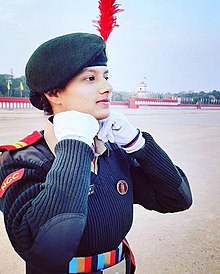
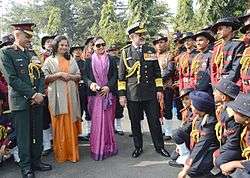
ALL INDIA GUARD COMMANDERS in REPUBLIC DAY CAMP
2019 - CSUO. SUMIT SAGAR (Agra UTTAR PRADESH)
Combined Annual Training Camps (CATC)
In C.A.T.C., the boys(Senior & Junior Division)and girl cadets(Senior & Junior Wing)of a particular NCC unit participate in the 10-day camp. Classes are conducted as per the given syllabus wherein certain aspects of NCC training are taught once again. The camp acts as a refresher training for the cadets and they are also trained in basic skills of survival and emergencies besides other topics. They are taught certain skills pertaining specifically to their Wing for e.g., a Naval cadet is trained in boat-rowing, oaring, Semaphore, etc. Another activity in the camp is the "dogwatch" wherein two cadets are to stay on sentry duty for two hours at any time given time of the day. Those caught sleeping, especially during late night or early morning shifts, or otherwise missing from duty are severely reprimanded or penalized. Cadets are also introduced to weapons such as a .22 caliber rifle. They are also given tasks of serving food to fellow cadets.
National Integration Camp (NIC)
NIC is to propagate national integration among cadets and society.'Only the best cadets in drills and march are sent to represent their states.'This camp is considered for SSLC and higher secondary course(+2) grace mark These camps are conducted on All India basis and help bridge the cultural gap among various States of India. In addition, there are six special NICs conducted at Leh, Nagrota (J&K), Chakabama (NER, Nagaland), Srinagar, Lakshadweep and Port Blair.
In this camp cadets are taught leadership quality and stage daring.
Advance Leadership Camp (ALC)
Advance Leadership Camp is conducted 6 times in various places throughout India. A cadet must have completed Basic Leadership Camp in order to qualify for this camp. In this camp the officers give cadets training for SSB screening and entrance.
Army Attachment Camp
These camps are conducted by the NCC in collaboration with Indian Army, as the willing cadets are attached to the specific regiments undergoing the training period of 10–15 days. In this camp, the cadets are trained by the instructors of the particular regiment, in the military tactics including day/night warfare & also get familiar with the weaponry.
Hiking And Trekking Camps
Adventurous treks and hikes up mountains take place, with expeditions to local mountains and hills.
Thal Sainik Camp (TSC)
The TSC is a 12 days camp conducted in Delhi every year in the late autumn, in which the cadets are selected from all 17 directorates (30+3 SD/JD and SW/JW cadets from each directorate), by the selection procedure conducting 3 pre-TSC camps each of 10–12 days in a week interval. The selected cadets then are sent to the TSC to represent their respective directorates in the following competitions:
- Obstacle course – In which the obstacles include 6-feet wall, zig-zag, double ditch, balancing, 3-feet bar, left bar, right bar, incline, etc. It is done after wearing full tactical gear with rifles.
- Firing – It consists of two types – Shooting (Grouping, Snap-shooting & Application). It is done with a standard .22 caliber rifle at the range of 25 meters & 50 meters.
- Map Reading – which includes working with a compass, service protractor & a map.
- Fieldcraft & battle craft.
- Tent pitching.etc.
Vayu Sainik Camp (VSC)
This centrally organised to camp is organised for Air Wing Cadets. Cadets from all directorates attend the camp. VSC is generally conducted in the month of October at Jodhpur.
Nau Sainik Camp (NSC)
This centrally organised Naval Camp is conducted annually for selected Naval Wing Cadets. Boat pulling, semaphore, whaler rigging, drill competitions are the main attraction of the camp. It is generally held at Naval Maritime Academy (NAMAC) at Visakhapatnam but started to be held at Karwar from 2014. Cdt Lakhvir Bawa was adjudged and won gold medal as Best cadet in 1995 from Kerala and Lakshadweep directorate.
All India Yachting Regetta (AIYR)
This centrally organised Naval Camp is conducted annually for selected Naval Wing Cadets. Yachting (Sailing) is the main attraction of the camp. It is generally held at Naval Base INS-Chilika at Odisha.
Rock Climbing Camps (RCC)
Eight rock climbing camps are held each year to expose the cadets to the basics of elementary rock climbing and to inculcate spirit of adventure amongst cadets. Four of these camps are held at Gwalior in Madhya Pradesh and other four camps at Nayyardam near Trivandrum in Kerala.
Naval Wing Activities
Naval wing syllabus is common for both boys and girls. During sea training naval subjects like Seamanship, Navigation, Communication, Gunnery, Damage Control and Ship Safety are taught to cadets. Swimming, Scuba Diving and Wind Surfing are other interesting activities.
Air Wing Activities
Gliding, Micro lite Flying( generally ZENAIR CH 701 STOL AC) and attachment training with Airforce Stations/Establishments are the main activities. 100 Pipistrel Virus SW 80 on order.[9][10]
Youth Exchange Programme
The aim of YEP is a country-to-country exchange of cadets belonging to NCC/equivalet Govt/Youth Organisations of friendly countries and participation in various activities and appreciation of each other's socio-economic and cultural realities.More than 150 cadets proceed abroad on YEP annually.
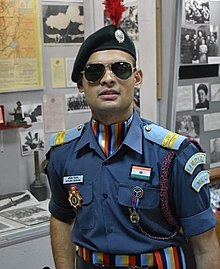
List of chiefs
| Director | Assumed charge on |
|---|---|
| Gopal Gurunath Bewoor | 31 Mar 1948[11] |
| Director General | Assumed charge on |
| Vinod Vashisht | 23 December 2016[12][13] |
| P. P. Malhotra | 11 Apr 2018[13][14] |
| Rajeev Chopra | 31 January 2019[15] |
See also
References
- "Size of NCC" (PDF). Archived from the original (PDF) on 2012-05-26. Retrieved 2011-10-28.
- "Handbook NCC" (PDF). Directorate of Tamil Nadu.
- "Paramilitary Forces of India". Mr.M.C. Sharma.
- "Motto of NCC | National Cadet Corps". nccindia.nic.in.
- "Directorates" (PDF). Government of India. Archived from the original (PDF) on 2012-05-26. Retrieved 2011-10-28.
- "RTI application" (PDF). NCC, India. Archived from the original (PDF) on 2012-05-26. Retrieved 2011-10-28.
- "RTI" (PDF). NCC. Archived from the original (PDF) on 2012-05-26. Retrieved 2011-10-28.
- "Republic Day Camp (RDC)". NCC. Archived from the original on 2013-08-14. Retrieved 2011-11-10.
- Malyasov, Dylan. "India Will Buy 194 Virus SW 80/10 Microlight Aircraft from Slovenia". defence-blog.com. Retrieved 7 August 2016.
- The Financial Express (12 October 2015). "India inks Rs 130-crore deal for 194 microlight aircraft". financialexpress.com. Retrieved 7 August 2016.
- "Genesis | National Cadet Corps". nccindia.nic.in.
- "Lt Gen Vinod Vashisht takes over as DG NCC". Business Standard India. 26 December 2016.
- "Lt Gen PP Malhotra takes over as DG NCC". pib.nic.in.
- "Lt Gen Malhotra takes charge as DG of NCC". India Today. PTI. 1 April 2018.
- "Lt Gen Rajeev Chopra takes over as NCC Director General". The Statesman. 31 January 2019.
External links
| Wikimedia Commons has media related to National Cadet Corps (India). |
- Official website
- NCC OTA Kamptee
- NCC KAR & GOA DIRECTORATE
- Maharashtra Directorate
- Delhi Directorate
- Punjab Directorate
- Andhra Pradesh Directorate
- Kerala Directorate
- Jammu & Kashmir Directorate
- Gujarat Directorate
- Odisha Directorate
MP & CG Directorate]
*NCC Application- https://play.google.com/store/apps/details?id=aspiration.foryouth